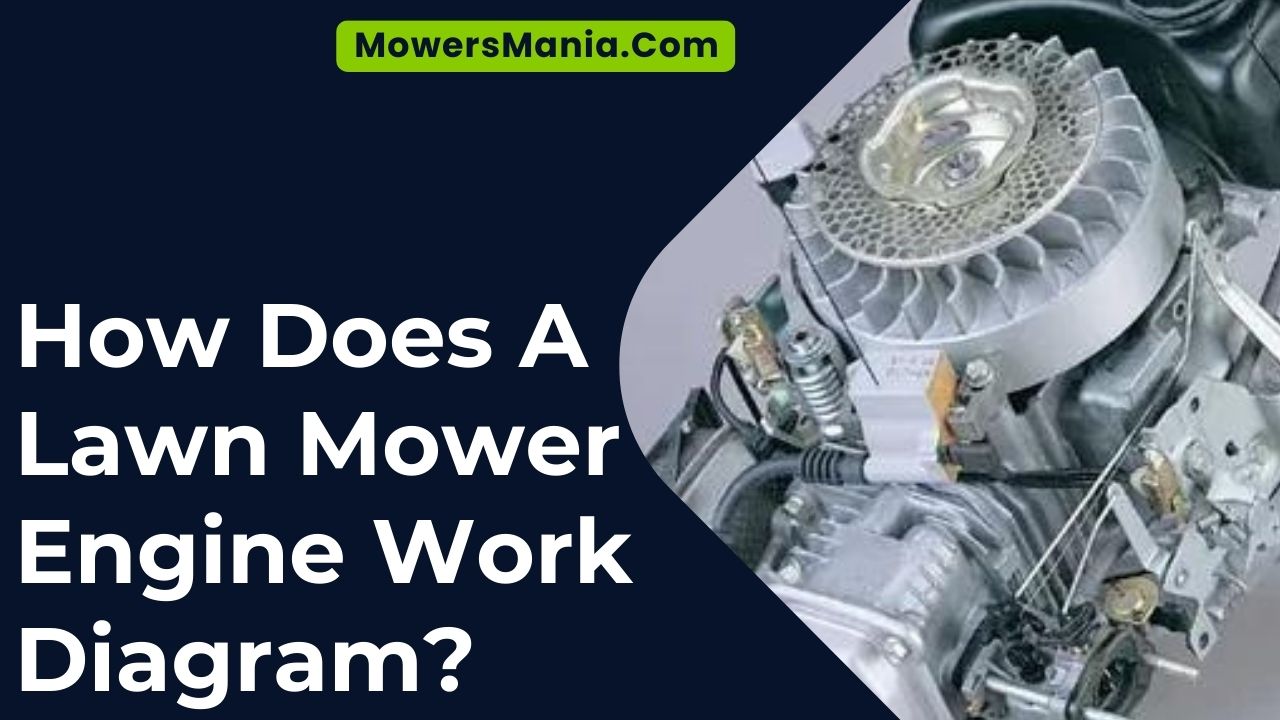If you’ve ever wondered how a lawn mower engine really works, this article breaks it down for you.
You’ll learn about the internal combustion process, engine components, fuel and air intake system, ignition sequence, and more.
Plus, we’ll provide a helpful diagram to visually guide you through the various parts of a lawn mower engine.
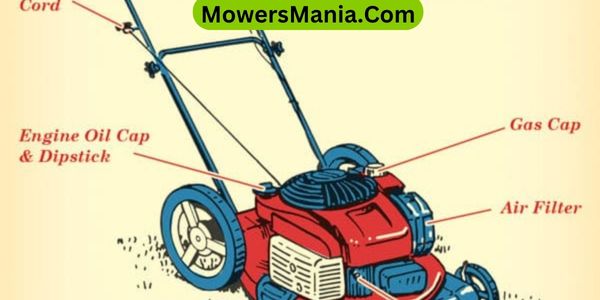
So, get ready to gain a deeper understanding of your trusty lawn mower’s inner workings.
Internal Combustion Process
You frequently start the internal combustion process in a lawn mower engine by pulling the starter cord. As you pull the cord, it rotates the engine’s crankshaft, which in turn initiates the process of drawing in a mixture of air and fuel into the engine’s cylinder.
Once the air-fuel mixture is inside the cylinder, the crankshaft continues to rotate, compressing the mixture to create a highly combustible environment. At this point, the spark plug ignites the compressed mixture, causing a small explosion within the cylinder.
This explosion forces the piston down, which in turn rotates the crankshaft and generates the power needed to drive the lawn mower’s blades. The exhaust from this explosion is then expelled from the cylinder, and the process begins anew as the engine continues to run.
Understanding this internal combustion process allows you to appreciate the intricate series of events that power your lawn mower and keep your lawn looking neat and tidy.
Engine Components Overview
An engine components overview provides a detailed understanding of the key elements that make up a lawn mower engine.
By delving into the various components, you can gain a deeper appreciation for the intricate machinery that powers your lawn mower.
Let’s take a closer look at the engine components and how they contribute to the overall functionality of the machine.
- Reliability: Understanding the components of your lawn mower engine can instill a sense of trust and reliability in the equipment. Knowing how each part works together to power the engine can give you peace of mind when tackling yard work.
- Maintenance: Learning about the engine components can evoke a sense of responsibility for the maintenance of your lawn mower. Regular upkeep and care can ensure that each component continues to function effectively, prolonging the life of your equipment.
- Empowerment: Having knowledge about the engine components can empower you to troubleshoot minor issues and make informed decisions about repairs or upgrades. This understanding can give you a sense of control over the performance of your lawn mower.
Fuel and Air Intake System
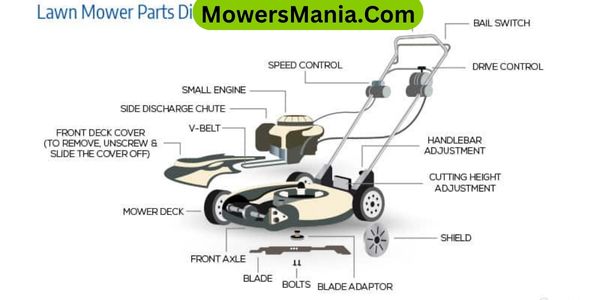
When you start your lawn mower, the fuel combustion process is crucial for generating power.
The air filter plays an important role in keeping dirt and debris from entering the engine, ensuring it runs smoothly.
The carburetor is responsible for mixing the right amount of fuel and air for combustion, keeping the engine running efficiently.
Fuel Combustion Process
The fuel combustion process in a lawn mower engine involves the intake of air and fuel to create the necessary mixture for combustion.
As the engine draws in air and fuel, it initiates a series of reactions that power the engine. This process is crucial for the engine to generate the force needed to rotate the blades and propel the mower.
Consider the following emotional aspects:
- Efficiency: Witness the efficient intake of air and fuel, ensuring optimal performance.
- Experience the satisfaction of knowing that every drop of fuel is utilized effectively, reducing waste.
- Power: Feel the surge of power as the fuel-air mixture ignites, driving the engine’s pistons.
- Embrace the sense of strength and capability as the engine converts fuel into motion.
- Reliability: Trust in the consistent delivery of the fuel-air mixture, ensuring smooth operation.
- Enjoy the peace of mind that comes with a reliable and steadfast fuel combustion process.
Air Filter Importance
Experience the importance of the air filter in maintaining the efficient intake of air and fuel for optimal performance in the fuel and air intake system.
The air filter plays a crucial role in preventing dirt, dust, and debris from entering the engine. Without a clean air filter, these contaminants can disrupt the air-to-fuel ratio, leading to decreased engine efficiency and potential damage.
By trapping these particles, the air filter ensures that only clean air reaches the engine, promoting better combustion and overall performance.
Regularly replacing or cleaning the air filter is essential to prevent clogging and maintain a constant flow of clean air into the engine. Neglecting the air filter can result in decreased power, increased fuel consumption, and even engine malfunction.
Therefore, the air filter is a vital component in the fuel and air intake system of a lawn mower engine.
Carburetor Function
To understand how a lawn mower engine works, you need to grasp the function of the carburetor in the fuel and air intake system. The carburetor plays a crucial role in mixing the right amount of air and fuel for combustion.
Here’s why it’s essential:
- Efficient Fuel Combustion: The carburetor ensures that the engine receives the optimal air-fuel mixture for efficient combustion, which directly impacts the mower’s performance.
- Engaging Experience: Understanding the carburetor’s function can enhance your overall experience of using a lawn mower as you appreciate the precision involved in fuel delivery.
- Smooth Operation: A well-functioning carburetor leads to smooth and consistent engine operation, making your mowing tasks easier and more enjoyable.
Understanding the carburetor’s function allows you to appreciate the intricate balance it maintains for efficient engine performance.
Ignition and Combustion Sequence
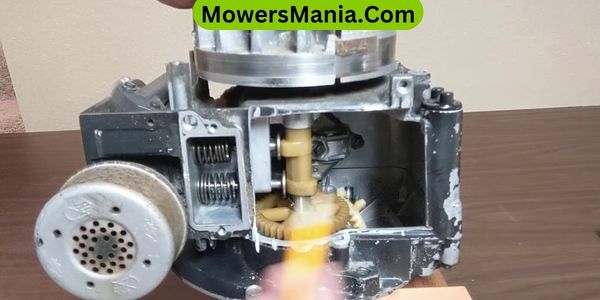
When you start your lawn mower, the ignition system creates a spark to ignite the fuel and air mixture in the engine.
This combustion sequence powers the engine, allowing the mower to operate.
Understanding the role of the spark plug and the combustion process is crucial for maintaining and troubleshooting your lawn mower engine.
Spark Plug Function
When the lawn mower engine is running, the spark plug functions to ignite the air-fuel mixture in the combustion chamber, initiating the combustion sequence.
This small but vital component plays a crucial role in ensuring the smooth operation of your lawn mower engine.
As the spark plug produces a spark, it sets off a chain reaction that culminates in the powerful force necessary to drive the engine. Consider the awe-inspiring moment when the spark plug ignites the fuel, propelling your lawn mower into action.
It’s like witnessing a tiny spark creating a controlled explosion, transforming potential energy into raw power.
The spark plug’s reliability and precision are essential for the seamless functioning of your lawn mower, ensuring it starts easily and runs efficiently.
Fuel and Air Mixture
The fuel and air mixture ignites to start the combustion sequence in the lawn mower engine, powering its operation.
When you pull the starter cord, the engine’s crankshaft spins, creating a vacuum that draws the fuel and air into the carburetor. The carburetor blends the air and fuel in the correct proportion, creating a highly flammable mixture.
Then, as the piston moves back up the cylinder on the compression stroke, the spark plug produces a spark that ignites the fuel and air mixture. This combustion generates high pressure, forcing the piston back down in the power stroke.
The energy from this controlled explosion is what ultimately drives the lawn mower engine, powering the cutting blades and wheels, allowing you to efficiently maintain your lawn.
Cooling and Lubrication Systems
To properly maintain your lawn mower engine, you must regularly check and maintain the cooling and lubrication systems.
The cooling system prevents the engine from overheating by circulating coolant through the engine block and cylinder head, while the lubrication system ensures that all moving parts are properly lubricated to reduce friction and wear.
Here’s why giving attention to these systems is crucial:
- Regular maintenance of the cooling system ensures that your engine operates at the right temperature, preventing potential overheating and costly repairs. Overheating can lead to engine damage, causing inconvenience and additional expenses.
- Proper lubrication of engine parts reduces friction, extending the life of your lawn mower engine and ensuring smooth operation. Well-lubricated parts minimize the risk of breakdowns, allowing you to complete your lawn mowing tasks without interruptions.
- Neglecting these systems can result in irreversible damage to your engine, leading to expensive repairs or the need for a replacement.
- Regular checks and maintenance save you time and money in the long run, ensuring your lawn mower engine runs reliably.
Diagram of Lawn Mower Engine Parts
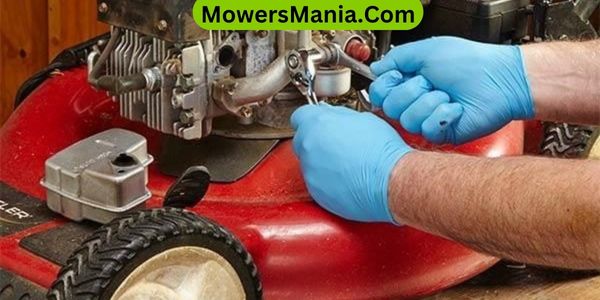
Check the diagram for a clear view of lawn mower engine parts. The main components include the engine block, piston, crankshaft, camshaft, valves, spark plug, fuel tank, carburetor, and muffler.
The engine block houses the internal components and provides structural support.
The piston moves up and down within the cylinder, converting the pressure from the expanding gas into mechanical force.
Connected to the piston, the crankshaft transforms the linear motion into rotational motion, which drives the mower blade.
The camshaft controls the opening and closing of the valves, regulating the flow of air and fuel into the combustion chamber.
Valves allow the air-fuel mixture in and the exhaust out of the cylinder. The spark plug ignites the compressed air-fuel mixture to initiate the combustion process.
The fuel tank stores the gasoline, which is fed into the engine through the carburetor.
Finally, the muffler reduces the noise produced by the exhaust gases. Understanding these parts is essential for maintaining and repairing your lawn mower engine.
Frequently Asked Questions [FAQs]
How Do I Know When It’s Time to Replace the Spark Plug in My Lawn Mower Engine?
When it’s time to replace the spark plug in your lawn mower engine, look for signs like difficulty starting the engine, rough idling, or decreased fuel efficiency. Changing the spark plug regularly helps maintain optimal engine performance.
Can I Use Regular Gasoline in My Lawn Mower, or Do I Need to Use a Specific Type of Fuel?
You can use regular gasoline in your lawn mower, but it’s recommended to use fuel with no more than 10% ethanol. This helps prevent engine damage. Always check the manufacturer’s guidelines for the specific type of fuel recommended.
What Maintenance Steps Should I Take to Ensure the Longevity of My Lawn Mower Engine?
To ensure the longevity of your lawn mower engine, change the oil regularly, clean or replace the air filter, check and replace spark plugs, and sharpen the mower blade. Also, keep the engine and mower deck clean.
Are There Any Environmentally-Friendly Options for Maintaining and Operating a Lawn Mower Engine?
To maintain and operate a lawn mower engine in an environmentally-friendly way, you can use bio-based oils, regularly tune up the engine, and opt for electric or manual reel mowers, which produce fewer emissions.
How Can I Troubleshoot Common Issues With My Lawn Mower Engine, Such as Starting Problems or Uneven Cutting?
If your lawn mower engine is giving you trouble, start by checking the spark plug, air filter, and fuel supply. Clean or replace any dirty or faulty parts. Also, ensure the blade is sharp for even cutting.
Conclusion
So that’s how a lawn mower engine works!
Understanding the internal combustion process, engine components, fuel and air intake system, ignition and combustion sequence, and cooling and lubrication systems gives you a better understanding of how your lawn mower engine functions.
With this knowledge, you’ll be better equipped to maintain and troubleshoot any issues that may arise, keeping your lawn mower running smoothly for years to come.

